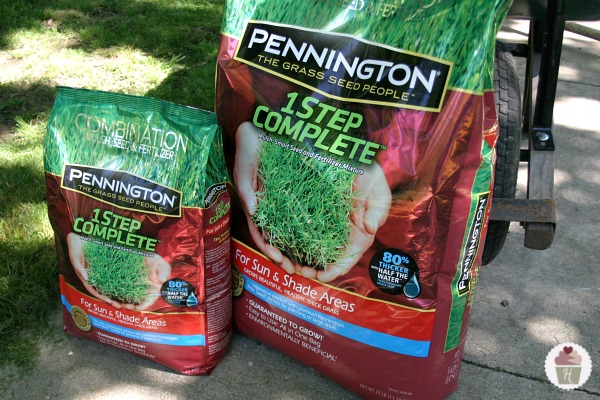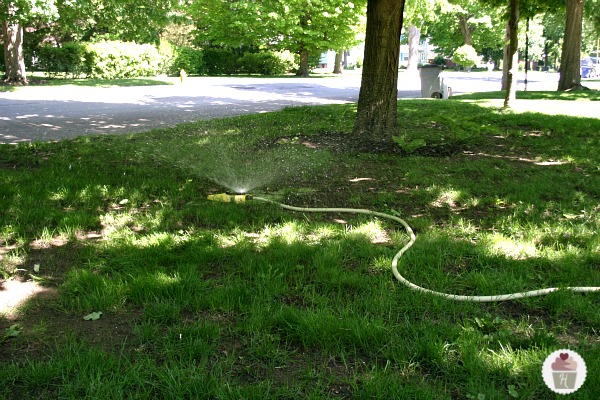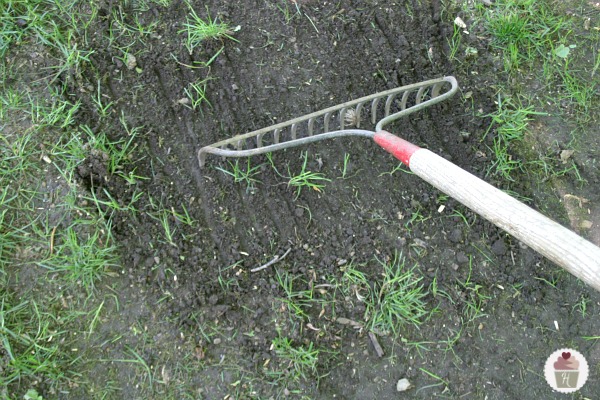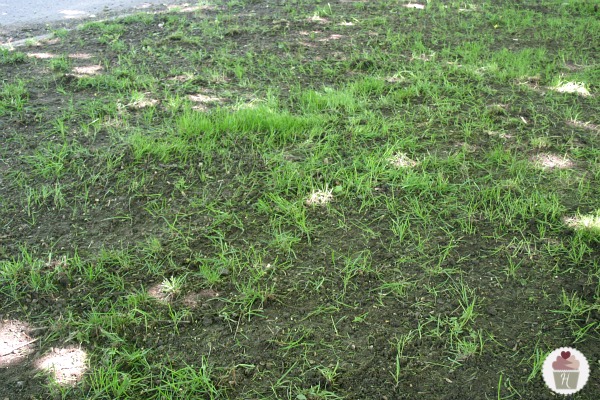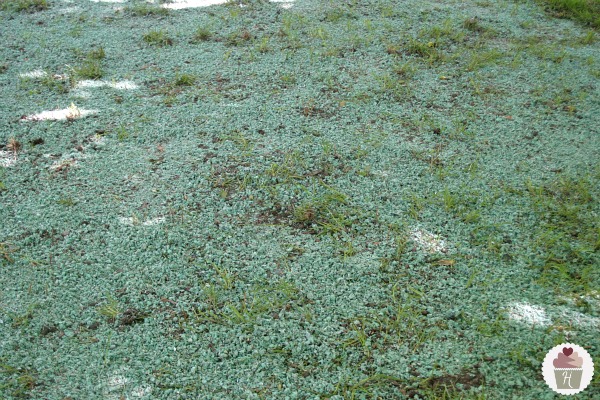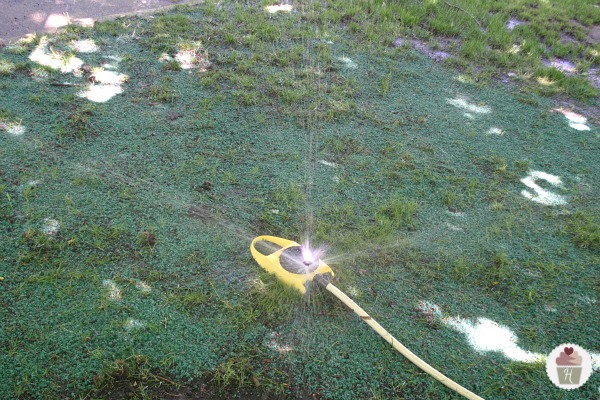Tips for Reseeding a Lawn

We’re counting down the days until Nick’s graduation party and my honey-do list continues to grow. One item I get to cross off the list is reseeding the lawn under our large Maple trees in the front yard. I’ve already done my research with the help of Pennington Seeds and tested my soil with an at-home soil test kit and applied the fertilizer and lime to get the soil to the best condition for the new seeding to grow.
Reseeding the lawn with Pennington 1-Step Complete was so easy I just had to share with you how I did it.
You’ll want to start with moist soil. If you can time it for after a good soaking rain that is the best, otherwise water the area… 1/4 inch is good.
Next set your mower on the lowest setting and cut the existing grass in the areas you’ll be reseeding. This makes the rest of the steps easier and lets you prolong mowing until the new seeding germinates.
Then you’ll take a bow (garden) rake and scratch the surface of the soil, down to 1/4-3/8 of an inch. Rake in two opposite directions.
Once you have this completed you are ready to apply the Pennington 1-Step Complete.
Simply spread by hand to a thickness of 1/4 inch.
Make sure you cover the area completely.
And then to finish the reseeding water thoroughly, and water lightly everyday for the first 30 days.
Disclosure: Pennington Seed, Inc. and their parent company Central Garden & Pet partnered with bloggers such as me to help educate us all about grass seed. As part of this program, I received compensation and was hosted by the company for a kickoff event. They did not tell me what to what to say about the use of the products. Central Garden & Pet believes that consumers and bloggers are free to form their own opinions and share them in their own words. Central Garden & Pet’s policies align with WOMMA Ethics Code, FTC guidelines and social media engagement recommendations.
Some of our readers had some questions concerning their problem areas in their lawns and the guys at Pennington were good enough to provide some answers…
Susan H.
My concerns are how to get grass to grow in the shaded areas of my back yard.
There are a broad range of different types of shade: light shade, full shade, heavy shade and dense shade. Shade can be the result of tree branches overhanging a yard or be the dense shadow cast by home. Based on where your lawn falls in this range, the recommendation would be to use a Sun & Shade or a Dense Shade grass variety. Sun & Shade is designed for areas of your lawn that receive variable sun and shade, while Dense Shade is made for problem areas with more shade than sun.
For smaller areas and repair-oriented applications, all-in-one combination products (mulch, seed and fertilizer), such as Pennington 1-Step Complete™, are ideally suited to fill in unsightly or dead patches with beautiful, healthy grass. Pennington 1-Step Complete™ is available in several specialized variety mixes, including Sun & Shade and Dense Shade. For larger areas, Pennington Smart Seed™ is available in Sun & Shade and Dense Shade.
Shana E.
I need help with our lawn. Weeds and moss take over so quickly, and growth uneven with big Evergreen trees surrounding it.
Lawn and garden enthusiasts have a great variety of products they can use to treat their lawns for weeds without harming the existing grass. Weed controls are generally bucketed into two categories— pre-emergent and post- emergent. Typically, pre-emergent treatments are applied in the fall or spring to prevent weed seeds from germinating. This will prevent Crabgrass and Poa Anna (in addition to other grassy weeds) from developing. Pre-emergent treatments can be done with granular products, such as Pennington Crabgrass Preventer plus Lawn Fertilizer or Pennington Crabgrass Control. Post Emergent weeds, i.e. weeds that are visible in the lawn, can be treated with combination granular products, such as Pennington Weed & Feed, which fertilizes a lawn while controlling broad-leaf weeds; or with liquid selective herbicide products, such as IMAGE Kills Nutsedge or IMAGE Kills Crabgrass water-soluble granules. Weeds can be tough to control and may require using a combination of different product types over the course of the growing season. It’s always important to read and follow the packaging instructions.
Moss is a huge issue in the Pacific Northwest and a growing issue along the East Coast. Homeowners have many treatment options, such as Moss Out! Brand products. Moss control products are specifically designed to eliminate moss on either structures or lawn and landscape area. These two categories use different active ingredients so make sure you use the right product in the right location. For lawn and garden treatments, homeowners can use products that either treat the moss (in granular or liquid form), or combination products that kill the moss while fertilizing your lawn (granular form). Structural moss control products are available in either liquid or granular form. As with weed care, it’s always important to read and follow the packaging instructions.
Chandra
Should you continue to seed year after year until you get the fullness you desire.
There are many benefits to reseeding, or overseeding, every year. Overseeding is just what it sounds like – sowing seed over existing grass in order to fill in the bare patches. Therefore, overseeding lawns makes sense only if the existing grass is healthy enough and abundant enough to be worth keeping. Often, this is an overlooked activity. Homeowners assume, incorrectly, that fertilizer is all that is needed. Even when well maintained, spot or general lawn reseeding with a specialty product is necessary to maintain long-term health and beauty. Lawns can thin or weaken due a range of issues. Overseeding thickens and strengthens your lawn.
Jessie
How often is watering recommended. I am pretty frugal and would like to minimize my water bill if at all possible.
Watering requirements can vary dramatically between germination, establishment and ongoing maintenance. During germination, homeowners should water to keep the soil moist. Following the first two weeks, homeowners should then water their lawn every third day for 15-20 minutes until established. As part of ongoing maintenance, watering should occur every fourth day for 20-30 minutes. At this stage, the main goal is to maintain a healthy lawn. This can be primarily accomplished by monitoring for color changes. A lawn does not need water until the color falls by 50 percent, at which time one inch of water should be added. To determine the length of irrigation, place plastic cups or small tins to observe waterfall in a given area.
To further promote moisture retention, homeowners should utilize a professional-grade mulch that will form a protective layer over the soil. The mulch contained within Pennington 1-Step Complete™ offers this benefit, along with a tackifier in the mulch to keep the protective layer in place so the seed does not wash away on a small hill or slope during rain. Pennington 1-Step Complete™ also contains Pennington Smart Seed™, a pure bred, drought resistant seed that requires up to 30 percent less water year after year versus common seed varieties. Together, the seed varieties and mulch technologies utilized in Pennington 1-Step Complete™ result in grass growth that is 80 percent thicker at 32 days with half the water required verses ordinary grass seed
Cori
My backyard is rough. It doesn’t get a ton of sun, and it backs up to a swamp. The ground is sandy and hard. I can’t seem to get anything to grow!
For starters, a soil test would be helpful. A soil test is used to evaluate the condition and levels of nutrients in the soil, namely pH, nitrogen, phosphorus and potassium levels. The pH scale ranges from 0 to 14. A pH of 7 is neutral, which is neither acid nor alkaline. Typically, lawns perform best at a soil pH level between 6.5 to 7 dependent on the type of grass grown. A soil’s pH level determines how well plants are able to draw the nutrients they need from the soil. Because soil pH levels tend to change over time, it’s important to test regularly. Homeowners can purchase a home soil test kit (available at most lawn and garden retailers) or have their soil tested by their local lawn care service provider. Once soil levels are understood, homeowners can balance out their soil with the addition of soil amendments and/or fertilizer. A fertilizer helps to supply the nutrients grass needs to grow properly.
There are a broad range of different types of shade: from light shade (i.e. a non-dense shadow cast by tree branches) to dense shade (i.e. all day shadow cast by a home). Based on where your lawn falls in this range, the recommendation would be to use a Sun & Shade or a Dense Shade grass variety. Sun & Shade is designed for areas of your lawn that receive variable sun and shade, while Dense Shade is made for problem areas with more shade than sun.
Christa
My back yard is covered with dandelions. And oddcrop circle type rings of dark green
RE: Dandelions. Lawn and garden enthusiasts have a great variety of products they can use to treat their lawns for weeds, such as dandelions, without harming the existing grass. Weed controls are generally bucketed into two categories— pre-emergent and post- emergent.
Typically, pre-emergent treatments are applied in the fall or spring to prevent weed seeds from germinating. This will prevent Crabgrass and Poa Anna (in addition to other grassy weeds) from developing. Pre-emergent treatments can be done with granular products, such as Pennington Crabgrass Preventer plus Lawn Fertilizer or Pennington Crabgrass Control.
Post-emergent weeds (i.e. weeds that are visible in the lawn) can be treated with combination granular products, such as Pennington Weed & Feed, which fertilizes a lawn while controlling broad-leaf weeds; or with liquid selective herbicide products, such as IMAGE Kills Nutsedge or IMAGE Kills Crabgrass water-soluble granules. Weeds can be tough to control and may require using a combination of different product types over the course of the growing season. It’s always important to read and follow the packaging instructions
RE: Dark green ring circles in lawn: This description is typical of fairy rings caused by a diverse family of fungi called basidiomycetes. Fairy rings might be six inches to two feet wide and can be anywhere from two feet to hundreds of feet in diameter and expanding yearly.
The presence of mushrooms usually indicates an organic source of nutrients, such as a buried tree stump, is nearby. When you see a mushroom growing in a lawn, you are only seeing a small part of the fungus. The fungus also grows underground as a thread-like mass that is called mycelium. This mycelium tends to grow in all directions from a central point. Thus, an invisible circular pattern occurs. The fruiting bodies (mushrooms) then tend to appear in a circular pattern.
The term “fairy ring” comes from a superstition that the mushrooms growing in a circle represent the path of dancing fairies. Usually on the inside of the fairy ring, a dark green ring of grass will be evident. This is because extra nitrogen is available in that area where the fungal mycelium has died.
This fungus is not easy to control. Mushrooms can be temporarily removed by regular mowing or raking. Since fairy rings are most visible on low fertility conditions, you can mask the fairy rings by regular applications of low rates of nitrogen. Alternatively, you can remove the affected lawn area plus several inches around and reseed the bare spot. As a pre-mixed combination product (mulch, seed and fertilizer), Pennington 1-Step Complete™ makes it easy to fill in unsightly or dead patches for beautiful, healthy grass.
